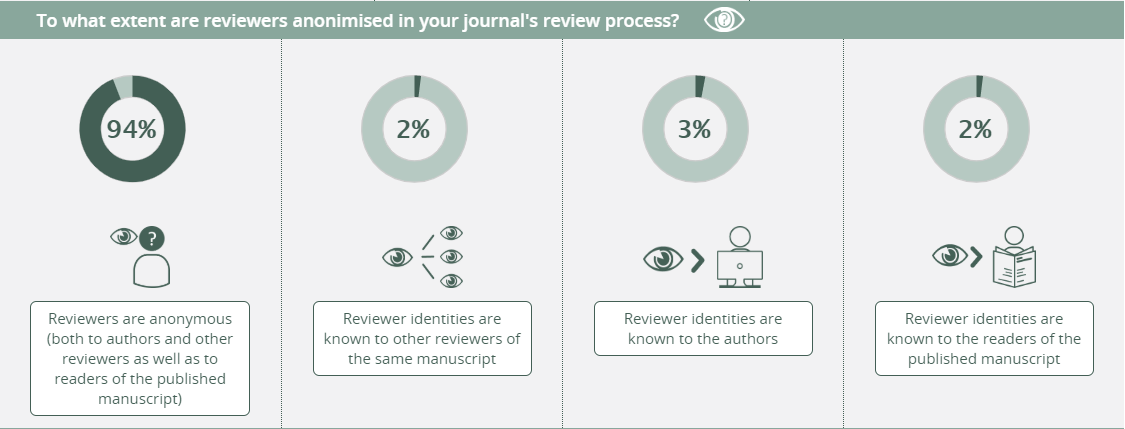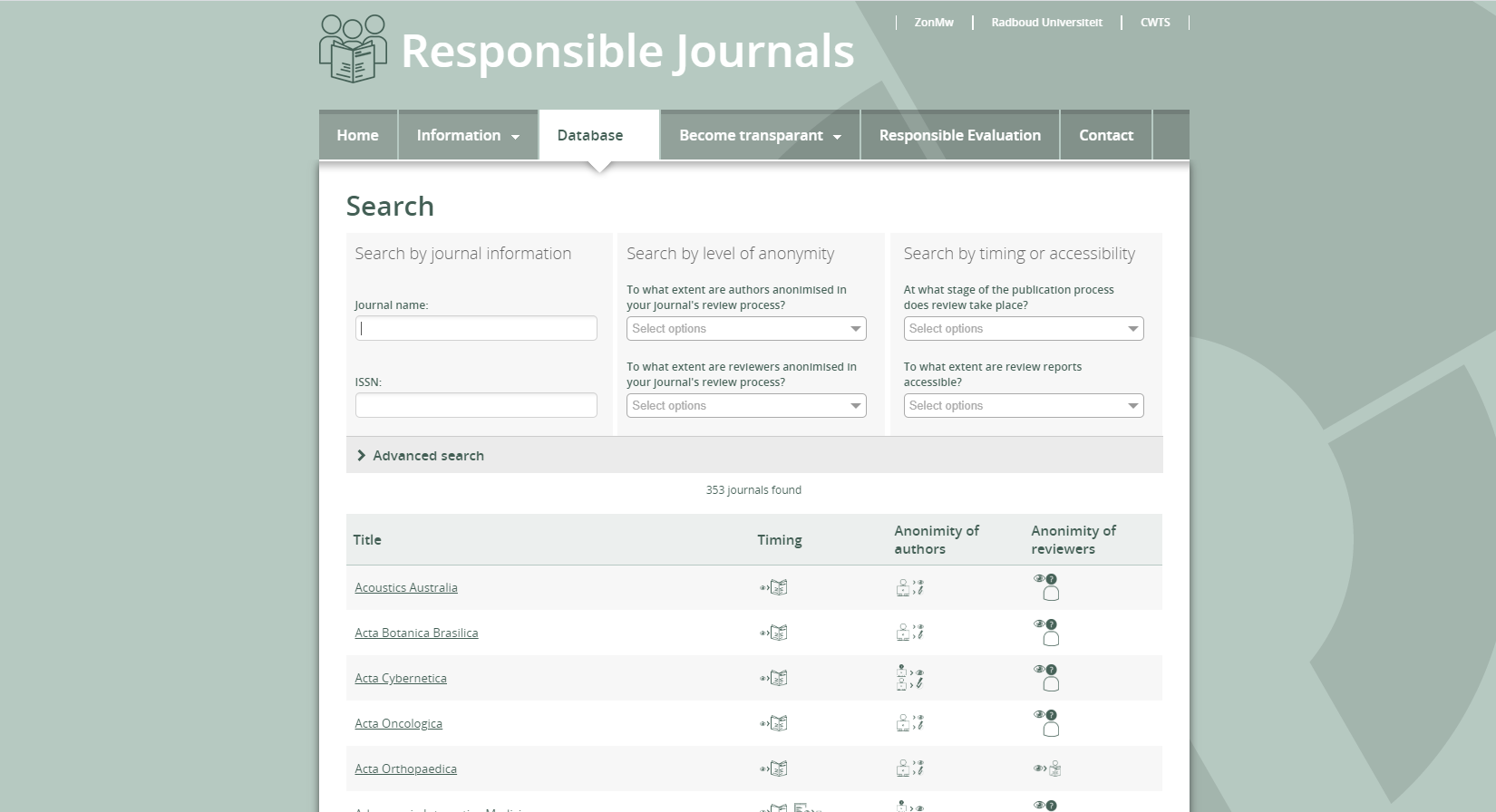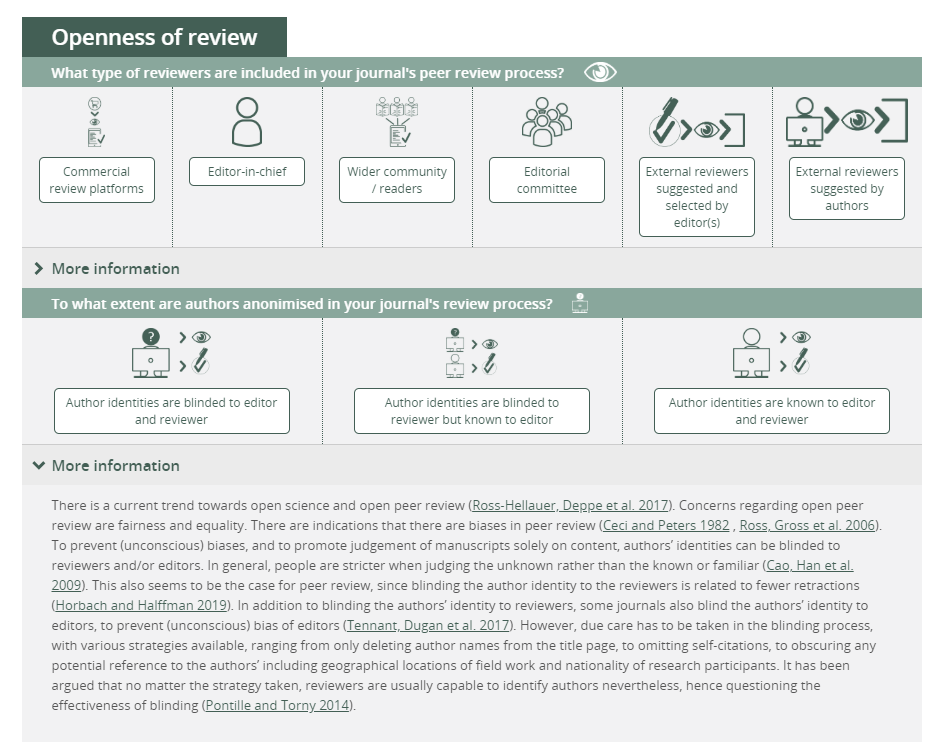Launch of Platform for Responsible Editorial Policies
We are happy to announce that, as of today, the Platform for Responsible Editorial Policies (PREP) is available via www.responsiblejournals.org.
What is PREP?
PREP is an online platform contributing to the responsible organisation of editorial procedures by scholarly journals. It facilitates journal editors to become transparent about their editorial procedures, advises journal editors and publishers on potential improvements of their peer review procedures, and presents integrated information about the variety of review procedures currently in use. PREP also maintains a database of journals’ current peer review formats and provides information and tools for journals to use journal metrics in a responsible way.

Screenshot of a part of PREP’s statistics page showing percentages of the level of anonymity of reviewers of journals in PREP.
Why do we need PREP?
The editorial assessment of journal submissions and the embedding of peer review in this assessment is becoming increasingly complex and diverse. Some journals are experimenting with radically new ways to judge whether manuscripts are fit for publication, such as mega journals abandoning importance or expected impact as a selection criterion. Other journals are moving beyond the idea that manuscripts reporting on research projects should constitute the nexus for assessment. Traditionally, peer review takes place between submission and publication of a manuscript. However, recently, two new forms of peer review timing have emerged; post-publication review, and pre-submission, in the form of registered reports.
The arrival of these innovations in an already diverse set of practices of peer review and editorial selection means we can no longer assume that authors, readers and reviewers simply know how editorial assessment operates. A recent call for more transparency of peer review procedures underlines the relevance of PREP, since PREP wants to contribute to editorial transparency by making information available on how journals organise the assessment of submissions. PREP also wants to help journal editors to document and make transparent their own assessment procedures. In addition, PREP wants to provide better knowledge of whether and how the various forms of editorial assessment contribute to improvements in the research publication system. To achieve these goals, PREP provides a database, support to clarify journals’ editorial assessment, and an overview of evidence of strengths and weaknesses for various forms of peer review and other editorial assessment procedures.
Database
First and foremost, PREP provides insight into specific journals’ peer review procedures in the form of a database based on a dozen questions. The answers to these questions characterise the editorial procedures of a journal, including the type of peer review used. This includes the anonymity level of authors and reviewers, whether digital tools such as plagiarism scanners are used, or the timing of peer review in the research and publication process. PREP displays which journals are using which procedures and presents aggregate statistics of their occurrence across journals. The answers of 353 journals to the dozen questions on their editorial procedures form the start of the openly accessible editorial procedures database.

Screenshot of PREP’s database.
The twelve questions on the journals’ editorial practices concern:
- Timing of the review process in the publication process
- Selection criteria
- Type of reviewers
- Author anonymity
- Reviewer anonymity
- Accessibility of review reports
- Interaction between actors
- The extent to which the review tasks are structured
- Statistical review
- The extent to which reviews from external sources are used
- Digital tools
- Facilitation of reader commentary as a form of post-publication review
Become transparent
PREP invites editors to provide the relevant information for their journals and thereby include them in the database. With this information, editors can facilitate transparency of review procedures and contribute to open science. Based on the answers to the twelve questions, PREP will include tailored suggestions for potential improvements to editorial procedures, including issues particularly relevant to the journal’s research area (such as the specialised review of statistics, if relevant).
PREP also suggests possible improvements on the journal’s transparency of peer review procedures and editorial policies such as policies on corrections and retractions, in line with the transparency declaration. To further help journals to become transparent about their editorial policies, PREP generates textual material that can be used on a journal’s webpage to foster transparency about its peer review procedures.
Information about peer review
With so many different shapes and flavours in editorial procedures, it might by now be difficult for journal editors to get a good and comprehensive overview of the possibilities for their editorial process. To address this, PREP provides web-friendly information about different review procedures. It explains the difference between various procedures, e.g. single-, and double-blind procedures, open review, or registered reports, including the rationale for their development and the evidence-base for their effectiveness in the literature. This information including infographics is freely accessible and can thus be used for information, training, and educational purposes.
With these features, PREP aims to contribute to more responsible journal management and to open science. By supporting authors, reviewers and editors in obtaining information about the editorial process of academic journals, it addresses well-known issues with one of science’s central institutions. By facilitating journal editors and publishers to transparently share their review procedures and by providing suggestions on alternative review options, it additionally aims to support some of the key stakeholders in academic publishing. This should ultimately lead to more open and responsible publishing.

Screenshot of a part of PREP’s information page on different peer review policies.
The PREP website was constructed by Henri de Winter, Patrick Kooij and Nees-Jan van Eck, together with the authors of this blog.





0 Comments
Add a comment